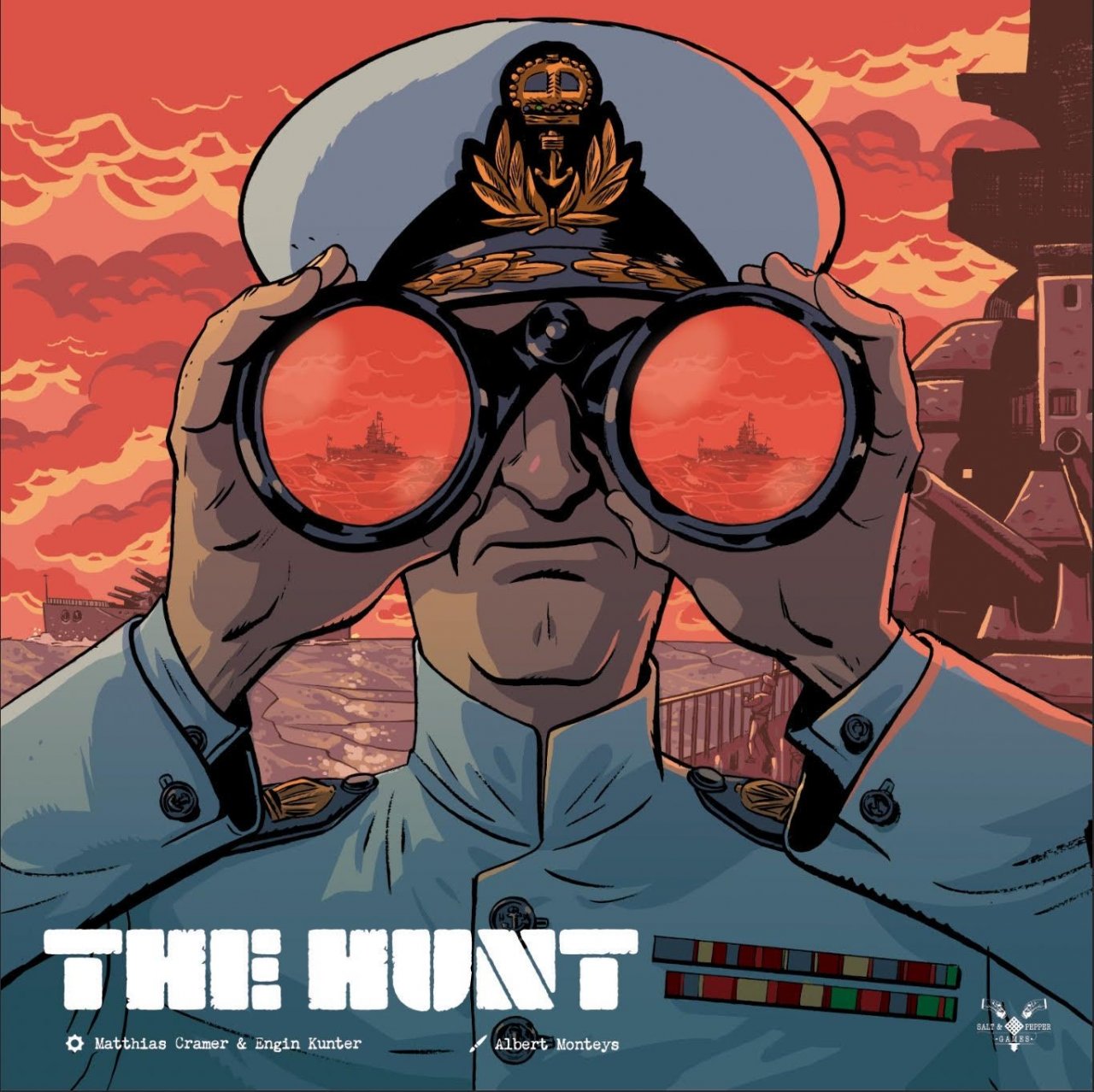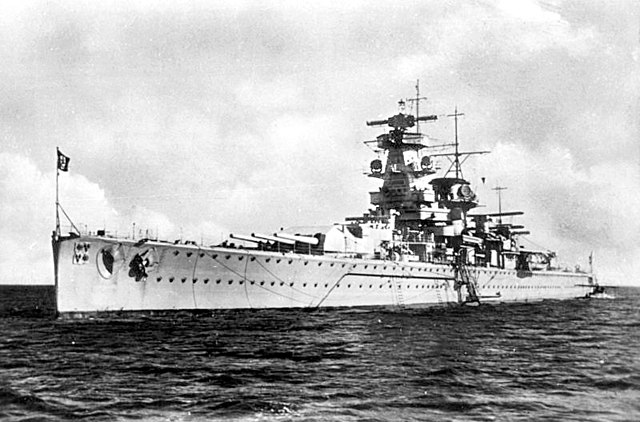The Hunt: the newest and exciting battleship board game

The board game tells Admiral Graf Spee’s events, a Kriegsmarine battleship hunted by the Royal Navy. Thought for two players, it hosts several elements that remind other board games, like the classical “Battleship”. The aim for the British player is to hunt the Graf Spee and engage (and win) a battle with her. Differently, the German player has to keep hiding and sink 5 cargo ships, or win the battle (which is unlikely).
How it works
After the preparation phase, the game expects two main phases; hunt and battle. It lasts usually for 45/60 minutes and uses a map divided in hexagons. There are also 36 event cards 18 for germany and 18 for britain, as well as markers. Inside map we can find some indicators, such as airplane bonus for the German side, the availablle reinforcements (“force”) for the British side, the three main starting ports and the battle damage counters. Graf Spee captain should also use paper and pencil.
Another main element are the freight ships cards, (the preys of the german player) each of them with a specific set route and randomly added in the board during britain player turn.
Board game Preparation

The board
Starting, players have to place their ships, (the german must note the Graf Spee position). Allied can choose only between the three ports, while the other can freely choose to deploy his battleship and his support ship (the Altmark) wherever he wants. The british side has also to place the first freight ships in the designed port.
Hunt phase
The name “Hunt” for this board game is not casual. In fact in this part, two main hunts are occorring: the German is trying to reach and sink as many cargo ships as he can, while the British is trying to find the Graf Spee position. To do so they both use the cards (5 for each player): every card has an amount of action points usable for moving and performing the search action, or they can choose to use the card’s event instead of points.
German movements
When the Graf Spee is in the same place as a cargo ship she can perform an attack rolling a dice. If she scores 5 or more that is a success and the cargo ship is sunk! However, doing so, he will reveal the Graf Spee’s position. The plane is a bonus available only for the german player which consists in a +2 to the dice number, but once used the plane must be repaired spending one Action Point and rolling a dice. If the dice is higher than the number of the german cards removed from the game since then, he can repair it, otherwise he will lost the airplane.
Players may move only one time and sink only one cargo for each turn. However, contrary to the british player, the Graf Spee can move again after performing a search/attack. German player has to note its position and he must tell the other player the number of AP he wants to use. However he can choose to say another number in order to mislead the enemy, adding to the game a great bluff mechanism.
British movements
The british player has to move the freight ships by one poisition each turn until they reach their destinatins. If a cargo reaches its arrival or the Axis sunk it, another one take its place on the starting port, and one of the players gets a point. A saved ship is a British point while a sunk one goes to Axis, until one of them reach five. The Allied movement and search is similar to the Axis one with the “Intelligence” bonus that works differently: spending one AP he can in fact choose if having a dice bonus or forcing the Graf Spee to place an hint marker in her vicinity making the search easier. Plus, every turn the he can spend 2 AP and advance one “Force” and after the fourth advancement a reinforcement ship can be placed on the board.
Battle phase
When the british player perform a search and the Graf Spee is there, the battle starts! Every player must draw cards until they both have 5 cards. There are 5 duels during this phase, and in each of them they secretly select a card and they show it simultaneusy: the one with less AP loses the round and get a hitmark. The Allied receive a dice bonus for each Force in the board. Also, the events in the cards happens, making the battles very unpredictable and creating more suspence. After 5 rounds, the player with less hits win!
Board game historical review
From an historical point of view, the information provided by the board game are all correct, but still, very poor. An important question we can raise (which the game fails to answer) is for example, how the Admiral Graf Spee managed to deal with an enemy fleet superior in numbers, resources and intelligence, practically alone.

German cruiser Admiral Graf Spee
Kriegmarine’s ship was in fact a miracle of engineering. Having the Germans, due to the Treaty of Versailles, permission to build only under 10.000 tons ships (making impossible to have a battleship) they used every newest technology to manage the Graf Spee (as well as her 2 sisters Deutchland and Admiral Scheer) to stay below the limits. Some innovations were the 2 Diesel engines (instead of steam, like the others), the soldering instead of nails and one of the first radars, making this ships ligher and faster than normal battleships but capable of the same firepower.
Learning from board game’s mechanism…
The plane and the intelligence bonus mechanics are both well made. From an historical point of view, in fact the airplane broke after a while, while the allied intelligence service was strong and ever present, being also the reason that made the Admiral Graf Spee sunk. In fact, after River Plate battle, the Allied made Langdorff believe that a giant fleet was approaching them during the fixing up in Montevideo, and he preferred to scuttle the ship than to lose it. The Altmark mechanism is also not bad in the board game mechanism, in fact it is not a smart move for the British to attack it and sink it since it was used to store freight prisoners. However both in game and in reality they can follow her for having hints on the battleship position.
…but not learning from descriptions
A weak point is the way of telling historical events. There are, in fact, many cards with historical accurate events, but with no other information about them. Cards in fact only explain their effects on the game, and only the rule book stores all the main information, making them avoidable. It is in fact very likely that both players play the game without even read the historical part, so without any understanding of events.
Conclusions
However, in its mechanichs the board game shows pretty well how a battle ship is, showing the struggle for finding enemy’s fleets before modern inventions such as radar (even if the graf spee had it) and satellites. The difficulties in finding and encountering each other forces was key in every kind of battle, no matter if it was in sea, land or air. The ability to divide, move faster and reunite your forces in a specific point has always been one of the key skills of the great commanders throughout history.
In conclusion we can say that it is a well made and funny game and that it teaches some general history only with its mechanic. However it fails in teaching the precise events unless the players want to search and know them.